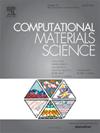Band edge engineering of CsPbI3 by surface decoration of halogen and alkaline atoms
IF 3.1
3区 材料科学
Q2 MATERIALS SCIENCE, MULTIDISCIPLINARY
引用次数: 0
Abstract
The inorganic halide perovskite, CsPbI3, has emerged as a promising material for photovoltaic applications. Effective strategy to tune its band edges is crucial to realize rational interface design with charge transport layers. In this work, by first-principle calculations, we found that surface decoration with halogen and alkaline atoms can effectively tune the electronic properties of CsPbI3. The introduction of these adatoms breaks the centrosymmetry of the CsPbI3 surface, resulting in the intrinsic electric dipole whose direction is determined by the charge transfer between the adatoms and the surface. The electric dipole then leads to a lateral electric field which redistribute the conduction and valence band edges to two opposite surfaces with a large electrostatic potential difference. Therefore, the electron and hole carriers are spatially separated, with the energy levels of band edges significantly shifted. Our work demonstrates surface decoration of halogen and alkaline atoms can effectively tailor the band edges of CsPbI3 and unveils the critical role of induced electric dipole moments, offering new opportunities for optimizing CsPbI3-based solar cell interfaces.

卤素和碱性原子表面修饰CsPbI3的带边工程
无机卤化物钙钛矿CsPbI3已成为光伏应用的一种有前途的材料。有效的带边调整策略是实现合理的电荷输运层界面设计的关键。在这项工作中,通过第一性原理计算,我们发现用卤素和碱性原子进行表面修饰可以有效地调整CsPbI3的电子性质。这些吸附原子的引入破坏了CsPbI3表面的中心对称性,导致本然电偶极子的方向由吸附原子和表面之间的电荷转移决定。然后,电偶极子导致一个侧向电场,该电场将导电带和价带边缘重新分配到具有较大静电电位差的两个相对表面。因此,电子和空穴载流子在空间上是分离的,带边缘的能级发生了明显的位移。我们的工作证明了卤素和碱性原子的表面修饰可以有效地定制CsPbI3的带边,揭示了感应电偶极矩的关键作用,为优化基于CsPbI3的太阳能电池界面提供了新的机会。
本文章由计算机程序翻译,如有差异,请以英文原文为准。
求助全文
约1分钟内获得全文
求助全文
来源期刊

Computational Materials Science
工程技术-材料科学:综合
CiteScore
6.50
自引率
6.10%
发文量
665
审稿时长
26 days
期刊介绍:
The goal of Computational Materials Science is to report on results that provide new or unique insights into, or significantly expand our understanding of, the properties of materials or phenomena associated with their design, synthesis, processing, characterization, and utilization. To be relevant to the journal, the results should be applied or applicable to specific material systems that are discussed within the submission.
 求助内容:
求助内容: 应助结果提醒方式:
应助结果提醒方式:


